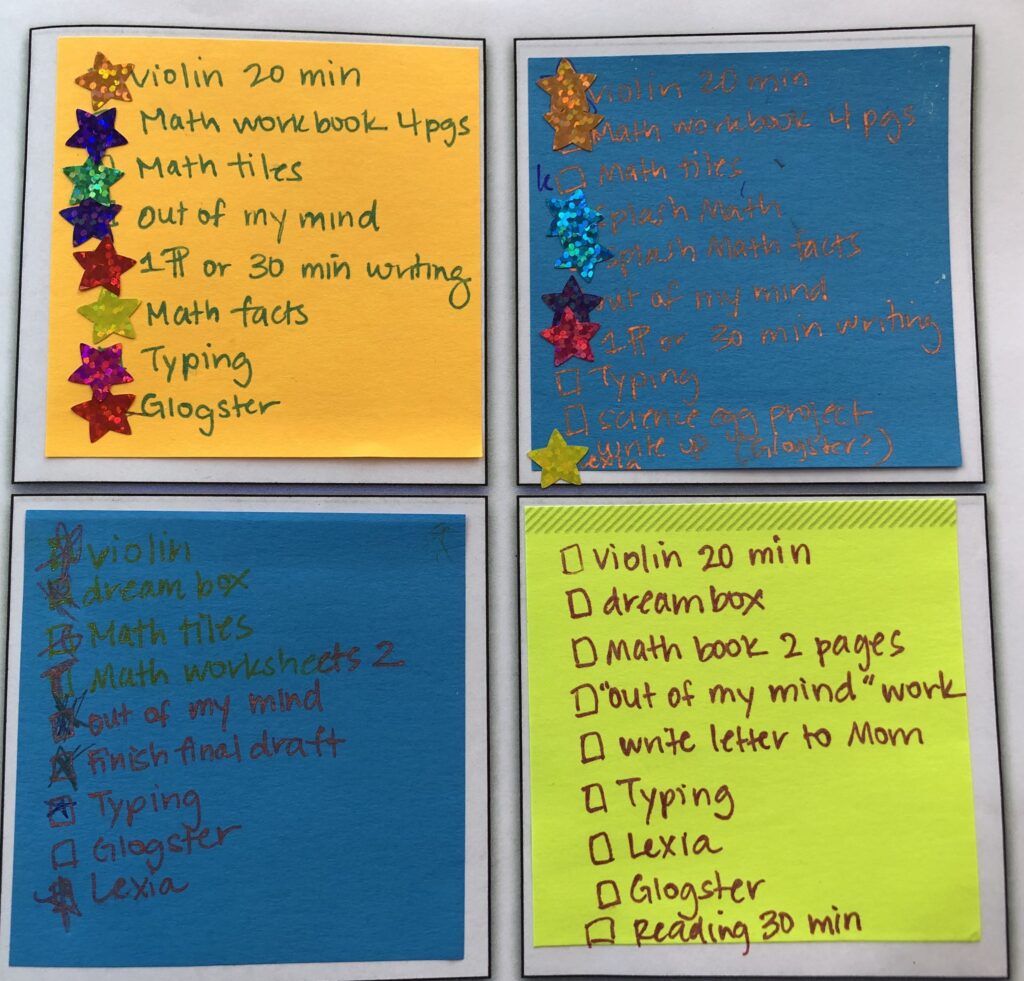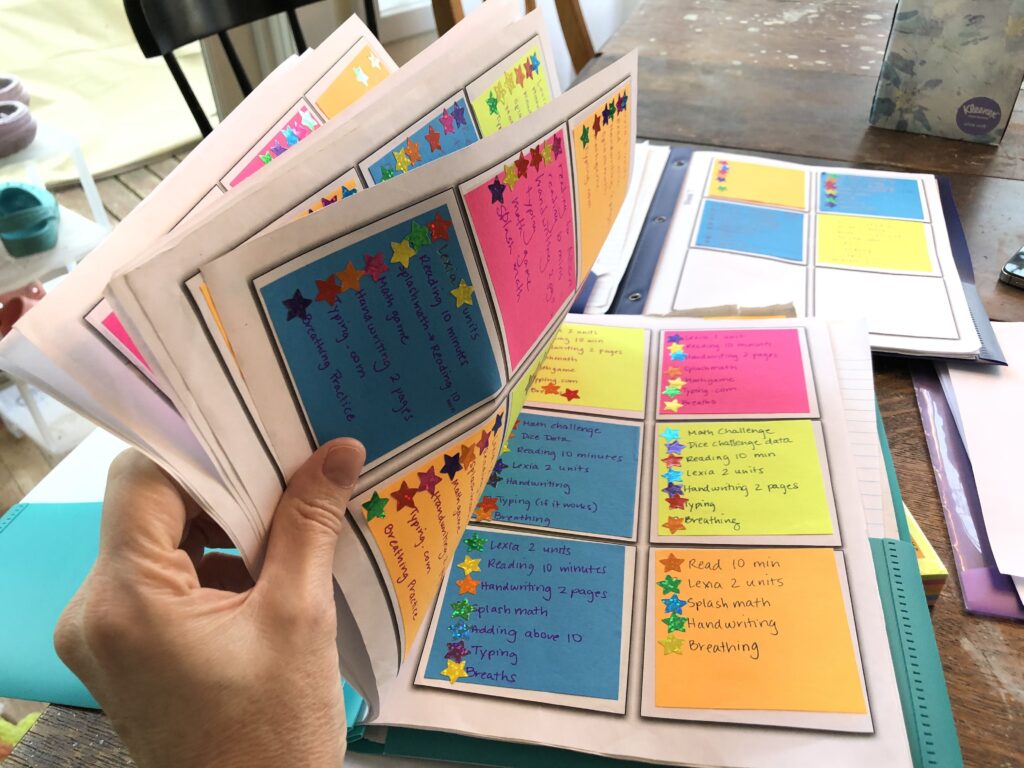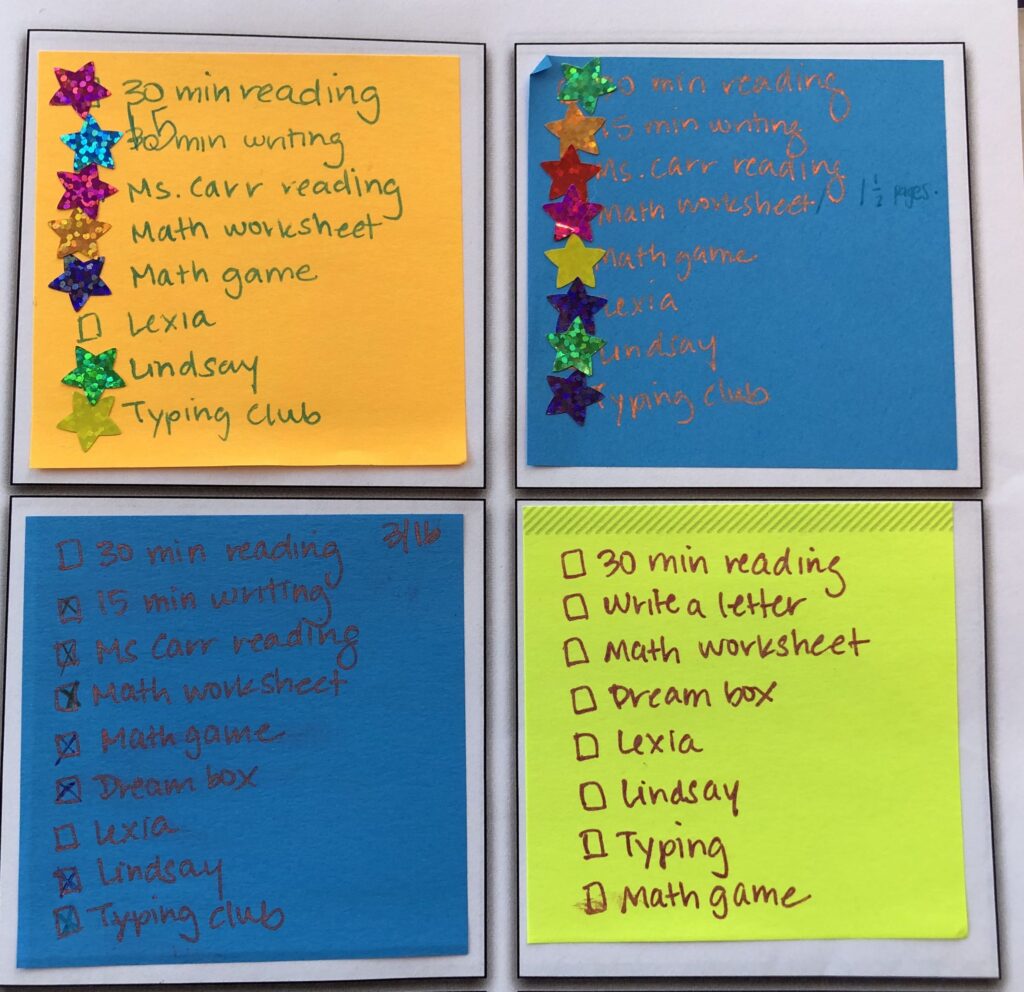How do you figure out what is the “right” amount of homework? This is one the hardest questions to answer. Luckily, you don’t have to. Your child will tell you, your job is to figure out how to listen to their answer.
First of all, you should know that the “right” amount of homework is always a moving target. So there is no right amount. The amount that a kid can handle will depend upon a variety of factors – how interested they are in the particular content, how overtired or hungry they might be in the moment, or how distracted or stressed they are by other things. Here are some recommendations when starting to figure out what the right amount of work is.
Start by guessing what the “right” amount of work is – I start everyday by laying out the homework that I want each child to get through. I think through what my longterm goals are for the girls and then translate those into daily goals to support them (see image below). For example, both my girls need to work on reading, writing, and mathematics. I want them to be engaged in these practices in a meaningful way (reading a book they love, writing a letter to someone, engaging in some problem solving or play around number, shapes, patterns, etc.) and I also want to make sure that I’m giving them an opportunity to work on some foundational skills (phonics, typing skills, math fluency), which will ultimately improve their access and engagement in these practices. I also make sure that their own personal academic goals are reflected (4th grader wants to work on a glogster about science and my 3rd grader wants to improve her typing). To give you an example of what this looks like in practice: on Day 4’s schedule for my 4th grader I have included (a) reading a book of her choice for 30 minutes, (b) writing a letter to her mom, (c) playing around with dreambox – an online math program. These activities allow her to engage in meaningful practices related to reading, writing, and math. For building up foundational skills I have included (a) Lexia – a phonics program from the school (b) typing practice and reading comprehension questions (her novel is called “out of my mind”), and (c) 2 math book pages. She also needs to work on 20 minutes of violin (part of her self-created schedule) and her glogster science site. Each day is a new guess about what the kid can get through. Every day I get a little bit better at guessing… but I still guess wrong. I use post-its to create a to-do list for each kid.

Consider both time-based goals and product-based goals – When you are laying out homework you can play around with both time-based goals (e.g., read for 30 minutes) and product-based goals (e.g., finish reading 1 chapter). One reason that I don’t exclusively use time-based goals is that those can disincentivize focused and deliberate work. If the child knows they are going to have to do 30 minutes of math- no matter what – they might decide to spend some of that time engaging in deliberate stalling. One reason I don’t use exclusively product-based goals, is because I want to give them credit for engaging in harder more time-consuming work. For example, if they just need to finish 1 chapter, they will choose the book based on which one has the shortest chapters. Children are masters at gaming the system. I’ve needed to play around with time-based vs. product-based goals at times to make sure I was incentivizing the right things.
Help them to see their progress – I use post-its for a variety of reasons. (1) It ensures I don’t try to put too much on the to-do list. (2) It enables the kids to have their list with them as they move through activities. (3) It allows me and the kids to see the evolution of their stamina and work over time (see below). Rather than a list that just gets thrown away at the end of the day – it’s a record of their hard work, and even if they don’t look back at it with a sense of pride, I do. I’m proud of what they have accomplished. Here is the template I use to attach post-its, and I tend to use super sticky post-its full adhesive, because I bought them accidentally once and they seem to work well for this purpose. You do NOT need to use this structure. You might have each kid use their planner or have a notebook, or maybe you do something digital. Play around with different systems and figure out what works best for you and your kids.

Listening to your children’s feedback – The most important thing to do is to practice listening to your child’s feedback about whether or not you’ve hit on the “right” amount of work for them for that particular day. This is admittedly easier said than done, and you won’t always get it right. Lots of time listening involves interpreting their behavior rather than listening to their words. Here are some ways that I try to listen to and respond to what the kids are telling me:
- Allow the child to make reasonable trades – Sometimes our kids will directly tell us that they don’t want to do something. Oftentimes if my kids aren’t in the mood to do a particular task, and they will ask to swap something out instead. In general, I let them make the swap. It helps them feel a sense of control and ownership over their to dos, and I just make a mental note to make sure that we hit that area the following day. I won’t generally let them swap the same thing (e.g., math for reading) over and over again.
- Evaluate the source of frustration – There are times when for whatever reason one of our girls will dig her heels in and refuse to do a particular task. For example, at this exact moment, my youngest is refusing to start working on the letter she is writing to her aunt. I ask myself – are we asking her to do something that is simply too hard for her? Is this particular demand too challenging? If not, we do not change our goals. Sure, writing a letter can be a daunting task, but what I’m asking her to do is not that. What I’m asking her to do is to name some things about her day or life to tell her aunt about. I’m writing those things down so she can use them for her letter later. I have given her ideas about some things that have been happening (e.g., finding leprechaun loot this morning in their leprechaun traps), and she’s at an absolute standstill. This is an example of a time when I’m unwilling to change my expectations. In this case, I’ve reminded her she can work on something else and after calming down, she has picked something else. (Update: Later she returned to writing the letter – and without any help from me finished it from start to finish.) It can be difficult sometimes to know when your kids are acting out because they are trying to control the expectations and when they are acting out because something is legitimately too hard.
- Questions you might want to ask your child when your child is refusing to do work:
- What about this is frustrating to you?
- What about this is hard?
- Can you show me what you are working on?
- How can I help?
- Questions you might want to ask your child when your child is refusing to do work:
- Negotiate when things are really challenging – Sometimes it will become evident that I have asked too much in one of my tasks (e.g., write a letter) or across all my tasks (too many total tasks). Particularly for my 3rd grader – she will often spend lots of time making it through one task, and simply run out of steam at the end of the day. When this happens I tend to make some deals. Generally I don’t cross things entirely off the list, but I come up with a compromised version (e.g.,” rather than doing 2 math worksheets, how about we do 1, and I’ll sit with you and help if you need it?”).
- Reduce, but never increase demands – Although I always try to listen to what the child’s behavior is telling me about if I found the “right” amount of homework for the day – the only change I let myself make is a reduction in homework. On bad days it makes sense to reduce expectations… but on good days… days when the kids seem to fly through their homework and they are focused and efficient, I often find myself wanting to tack just one more thing onto their list. But I can’t – not EVER. I want to reward their focused and efficient progress through the work… and if I add more thing to their to-do list after they finish what I initially asked of them, they will feel like they were punished. So, even when I guess really wrong at the start of the day, and I realize I haven’t asked one of them to do enough, I can’t add more things later. I think this helps build trust in the post-it “contract” that we have. If they work through what is on the list, they can have free play time after it’s done.
Reflect on the day when planning for the next – We can improve our guess about the “right” amount of homework by reflecting in the current day to plan the next. For example, on day 1 (see post-its below), I stuck with the recommendations of the teachers that my 3rd grader should be doing 30 minutes of writing every day. We discovered that this was WAY TOO much for her. My daughter and I talked about what would be reasonable for her, and we decided that 15 minutes a day would be a good place to start. She took it upon herself to update our homework list for the day. The following day, I scheduled her for only 15 minutes of writing and she did twice as much quality writing as she had done on day 1. Day 3 she finished her writing task, and now for Day 4 I thought we would take a break from persuasive writing and shift to a different genre – letter writing. It will help her connect with some of her first family that live far away and may be motivating for her. This is the first day of the product-based task “write a letter” and we will probably find that writing a WHOLE letter will be too ambitious, and we’ll tweak that goal for tomorrow. The important thing is not to get it “right” but to work with your kids to figure out what is right for them. You might also notice that on Day 1 we didn’t get to Lexia work – that meant that we tried to get through more Lexia work the next day.

In this post I shared a bit about how I try to right-size the amount of work I’m asking my children to do – let me know if you have other suggestions or if you’d like me to think through specifics of what you are facing with your child or children. Best of luck – this is hard work!